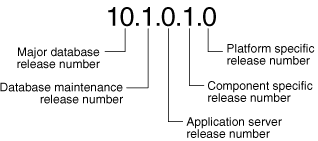| Oracle® Database Administrator's Guide 11g Release 1 (11.1) Part Number B28310-01 |
|
|
View PDF |
| Oracle® Database Administrator's Guide 11g Release 1 (11.1) Part Number B28310-01 |
|
|
View PDF |
Because Oracle Database continues to evolve and can require maintenance, Oracle periodically produces new releases. Not all customers initially subscribe to a new release or require specific maintenance for their existing release. As a result, multiple releases of the product exist simultaneously.
As many as five numbers may be required to fully identify a release. The significance of these numbers is discussed in the sections that follow.
To understand the release nomenclature used by Oracle, examine the following example of an Oracle Database server labeled "Release 10.1.0.1.0".
Figure 1-1 Example of an Oracle Database Release Number

Note:
Starting with release 9.2, maintenance releases of Oracle Database are denoted by a change to the second digit of a release number. In previous releases, the third digit indicated a particular maintenance release.The first digit is the most general identifier. It represents a major new version of the software that contains significant new functionality.
The second digit represents a maintenance release level. Some new features may also be included.
The third digit reflects the release level of the Oracle Application Server (OracleAS).
To identify the release of Oracle Database that is currently installed and to see the release levels of other database components you are using, query the data dictionary view PRODUCT_COMPONENT_VERSION. A sample query follows. (You can also query the V$VERSION view to see component-level information.) Other product release levels may increment independent of the database server.
COL PRODUCT FORMAT A35 COL VERSION FORMAT A15 COL STATUS FORMAT A15 SELECT * FROM PRODUCT_COMPONENT_VERSION; PRODUCT VERSION STATUS ---------------------------------------- ----------- ----------- NLSRTL 10.2.0.1.0 Production Oracle Database 10g Enterprise Edition 10.2.0.1.0 Prod PL/SQL 10.2.0.1.0 Production ...
It is important to convey to Oracle the results of this query when you report problems with the software.